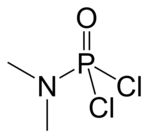Dimethylamidophosphoric dichloride
This article needs additional citations for verification. (September 2023) |

| |

| |
| Names | |
|---|---|
| IUPAC name
N-Dichlorophosphoryl-N-methylmethanamine
| |
| Other names
(Dimethylamido)phosphoryl dichloride
N,N-Dimethylphosphoramidodichloridate | |
| Identifiers | |
3D model (JSmol)
|
|
| ChemSpider | |
PubChem CID
|
|
| UNII | |
CompTox Dashboard (EPA)
|
|
| |
| |
| Properties | |
| C2H6Cl2NOP | |
| Molar mass | 161.95 g·mol−1 |
| Melting point | < 0 °C (32 °F; 273 K) |
| Hazards | |
| GHS labelling: | |
  
| |
| Danger | |
| H314 | |
| P260, P264, P280, P301+P330+P331, P303+P361+P353, P304+P340, P305+P351+P338, P310, P321, P363, P405, P501 | |
| NFPA 704 (fire diamond) | |
Except where otherwise noted, data are given for materials in their standard state (at 25 °C [77 °F], 100 kPa).
| |
Dimethylamidophosphoric dichloride is a chemical used in industrial applications. It is used for synthesizing phosphoramidates as well as tabun, which is used as a chemical weapon.
Safety
[edit]Due to its nature, this chemical is corrosive, flammable, and neurotoxic if ingested or absorbed through the skin.[1] In contact with water, it is expected to give off hydrogen chloride and dimethylamidophosphoric acid vapors.[2]
History
[edit]First synthesis of the substance dates back to turn of the 19th century, when a student of German chemistry professor August Michaelis Ernst Ratzlaff made dimethylamidophosphoric dichloride as well as its diethyl analog for experiments of another PhD student of Michaelis Adolph Schall.[3] He obtained a PhD at University of Rostock with a thesis titled Über die Einwirkung primärer und sekundärer Amine auf Phosphoroxychlorid und Äthoxylphosphoroxychlorid later in 1901. The high toxicity of the substance (as well as the high toxicity of ethyl diethylaminocyanophosphonate, an analog of tabun synthesised by Schall) wasn't noticed at the time, most likely due to the low yield of synthetic reactions used.
See also
[edit]References
[edit]- ^ "Dimethylamidophosphoric dichloride". www.chemsrc.com. Retrieved 2023-09-19.
- ^ "N,N-DIMETHYL PHOSPHORAMIDIC DICHLORIDE | CAMEO Chemicals | NOAA". cameochemicals.noaa.gov. Retrieved 2023-11-15.
- ^ Petroianu, Georg (2014). "Pharmacists Adolf Schall and Ernst Ratzlaff and the synthesis of tabun-like compounds: a brief history". Die Pharmazie. 69 (October 2014): 780–784. doi:10.1691/ph.2014.4028. PMID 25985570.

